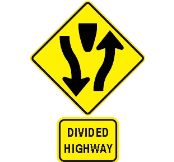White lines separate traffic lanes traveling in the same direction. You may cross broken white lines to pass, as long as the passing lane is clear.
When turning, you should reduce to a speed that allows you to maintain control of your vehicle, stay in your lane, and react to unexpected situations.

Warning signs are usually diamond-shaped with black markings on a yellow background. They alert drivers to upcoming hazards. This warning sign indicates that drivers are about to encounter a divided highway.
Your ability to handle dangerous traffic situations depends largely on searching for and identifying problems before meeting them. Looking far ahead of your vehicle does not mean you should simply stare at the center of the road. You need to continually scan the entire road, including the sides of the road.
If your vehicle’s accelerator sticks open, your vehicle will continue to maintain its speed or accelerate, even if you remove your foot from the gas pedal. Turn off the ignition, using care to move the ignition switch only far enough to stop the engine and not engage the steering wheel locking mechanism. Apply your brakes and move off the road to a safe area
Reduced conflict intersections are intersections that decrease fatalities and injuries caused by broadside crashes on four-lane divided highways. At a reduced conflict intersection, drivers always make a right turn. The right turn is followed by a U-turn if a driver wishes to change direction
Compared to signs and other roadside objects, pedestrians are hardest to see at night.